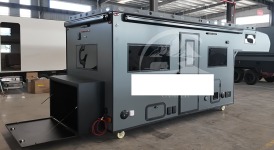So... what size cable did you run over what length?
4 awg - 13 ft
Attachments
Last edited:
So... what size cable did you run over what length?
You obviously size cabling very differently than I do...4 awg - 13 ft
The setups that I have seen with this specific AC unit have used much thicker cable that you plan to use, hence my original comment.My main concern with this unit is the size of the cabling you need to run to it.
You obviously size cabling very differently than I do...
At 80 amps with 4AWG wire that is 13 feet long (actually 26 feet, as you need to calculate using both positive and negative) you will get a voltage drop of 0.52 volts, which is 3.92%.
That is beyond what I would consider acceptable, especially when driving a motor, which is what an AC compressor is.
This will also be a continuous load, not an intermittent load, so I am guessing that your wiring is going to get pretty hot when running at full load.
All of my camper wiring has been designed to have less than a 2% voltage drop and most of the wiring that powers a motor is around 1% (fridge, actuators etc.).
As the voltage drops, the current increases, as the load tries to draw the power it wants. If the wiring is undersized this additional current draw will result in more heat being generated.
Also, if your cabling is run inside your walls, or inside conduit, then you need to derate the current capacity of the wire, as any generated heat cannot escape as easily.
The setups that I have seen with this specific AC unit have used much thicker cable that you plan to use, hence my original comment.
I based my comment on the information YOU provided.This cable must support 12v - 80 amp load.

I bet you are happy it is done and ready to shipHas Lianyungang Leisure Camper given you a time frame on shipping from Zhengzhou to Shanghai (maybe Lianyungang ?) and then on to the USA? I'm guessing the shop that built your subframe will install the camper (via: crane, jacks, or ?) and then you should be ready to go? It will be awesome to see the finished rig. The color is great, especially with the black, and the roof rack looks great. And two awnings, nice.
A website worth checking out if you haven't already is Vantripping.com he is building a camper and has been documenting each stage with pretty detailed video's of how he went about cutting his pass-through.
Building a cab to camper pass thru on an expedition camper
